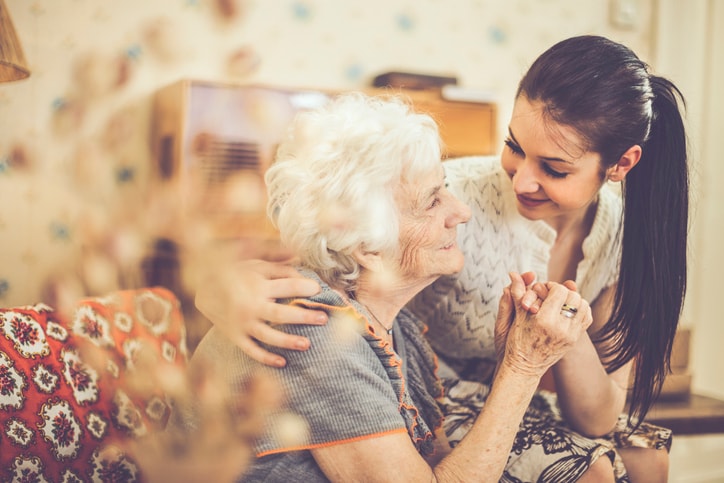With summer on the horizon and the light at the end of the tunnel of a global pandemic becoming brighter every day, families whose older loved ones receive professional senior care are now grappling with the aftermath of the pandemic, according to data from the new Care.com 2021 Senior Care Outlook Survey.
Family caregivers and older adults are both concerned about their financial well-being and struggling to see eye-to-eye on care options, torn between senior living communities and aging in place. Here, the key findings and insights that illustrate the challenges families are contending with as they tackle senior care moving forward.
How the pandemic has impacted families’ views on senior care
The pandemic has led to a variety of financial and emotional concerns — as well as a few bright spots — for both older adults and the loved ones who oversee their care, according to the survey data.
1. Home care is on the rise
Both seniors and adult children report that they anticipate increasing the types of home care they use moving forward. Before the pandemic, older adults relied most on:
- Household help/errands (43%).
- Medical/specialized care (40%).
- Transportation (32%).
- Mobility assistance (31%).
As we move further into 2021, seniors are planning to increase every type of care in the next year or two — particularly household help (+10%) and mobility assistance (+9%).
Similarly, pre-pandemic, adult children depended most on the following types of care for their older loved ones:
- Household help (56%).
- Personal care and medical/specialized care (both 54%).
- Transportation support (46%).
Moving forward, they anticipate an increase in all of these categories, but especially mobility assistance (+12%) and household help (+10%).
2. Family caregivers are split on the best kind of care while seniors would rather age in place
According to the survey, 67% of adult children say the type of care they prefer for their aging loved one has shifted as a result of the pandemic, whether they’ve shifted in favor of aging in place (32%) or shifted in favor of senior living communities (35%).
Despite the loneliness and isolation that the pandemic might have brought seniors who were living alone, 62% of older adults say their preferences remain unchanged. Aging in place ranked first (43%), followed by living with family (35%).
In both groups, people who changed their preference from aging in place to a senior community had nearly identical reasons for the switch.
Seniors ranked their concern as follows:
- Safety (28%).
- 24/7 support (27%).
- Fear of isolation/another lockdown (22%).
- Financial concerns (16%).
Meanwhile, family caregivers priorities differed just slightly:
- 24/7 professional support (29%).
- Safety (27%).
- Fear of isolation (23%).
- Financial concerns (21%).
Still, some family caregivers who would prefer their older adult age in place versus go to a senior living community. They cite the following reasons for their choice:
- Negative media coverage (21%).
- Fear of isolation (20%).
- Not being able to reach their older loved one when necessary (20%).
3. Family caregivers see the conversation around care as difficult
Survey responses also showed 53% of adult children anticipate that talking through senior care options with their loved ones will be difficult while only 33% of seniors feel that way.
- Only 33% of adult children say they strongly agreed with their older loved one about senior care options before the pandemic, while 23% disagreed.
- 40% of seniors-with-children say they strongly agreed with their adult children about their care before the pandemic, while 25% disagreed.
4. Vaccinations are making seniors and family caregivers hopeful
As more family caregivers and older Americans get their shots, both parties are adopting a sunnier outlook.
- 91% of adult children report vaccination (or vaccination plans) for their seniors, prompting optimism and a decrease in fear.
- 68% of adult children and 70% of seniors are optimistic that COVID-19 vaccines will help Americans generally return to pre-pandemic norms.
- 56% of adult children and 72% of seniors say that COVID-19 vaccines have made them less fearful for their senior’s general well-being.
- Both adult children and seniors anticipate big plans post-vaccination:
- Of seniors who are vaccinated, 76% are more likely to see their adult children in person; 58% are much more likely.
- 96% of adult children with vaccinated older loved ones and 98% of older adults report plans to do at least one pandemic-restricted activity.
- Seniors are most excited to see friends and family in person (42%), followed by going shopping (36%), eating at a restaurant (35%), travelling (28%) and going to a movie theater (16%).
5. The vaccine could also change how families approach care
Of those surveyed, 73% of adult children say their older loved one currently lives in their own home, the adult child’s home or another family member’s home. Of those who live in a house, 53% say the vaccine makes them more likely to recommend that their senior move to a senior living community.
By comparison, of seniors who live in a house, only 23% say that the vaccine makes them more likely to move to a senior living community.
Care.com Senior Care Outlook Survey – Adult Children Methodology
This scientific sample of 1,000 US adults (18 years or older) who are all paying for professional senior care was surveyed between April 19 and April 20, 2021. The margin of error is ±3.1%. No additional weighting was done to the initial sample, and no post-stratification of results was applied. DKC Analytics conducted and analyzed this survey with a sample procured using the Pollfish survey delivery platform, which delivers online surveys globally through mobiles apps and the mobile web along with the desktop web.
Care.com Senior Care Outlook Survey – Seniors Methodology
This scientific sample of 750 US adults (65 years or older) who are all paying for professional senior care was surveyed between April 19 and May 16, 2021. The margin of error is ±3.6%. Post-stratification of results was applied to weight age in alignment with US population demographics. DKC Analytics conducted and analyzed this survey with a sample procured using the Pollfish survey delivery platform, which delivers online surveys globally through mobiles apps and the mobile web along with the desktop web.
About Care.com
Available in more than 20 countries, Care.com is the world’s leading platform for finding and managing high-quality family care. Care.com is designed to meet the evolving needs of today’s families and caregivers, offering everything from household tax and payroll services and customized corporate benefits packages covering the care needs of working families, to innovating new ways for caregivers to be paid and obtain professional benefits. Since 2007, families have relied on Care.com’s industry-leading products — from child and senior care to pet care and home care. Care.com is an IAC company (NASDAQ: IAC)





